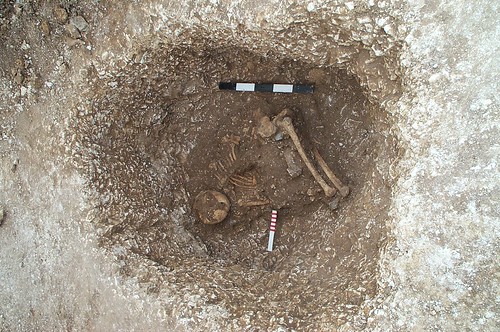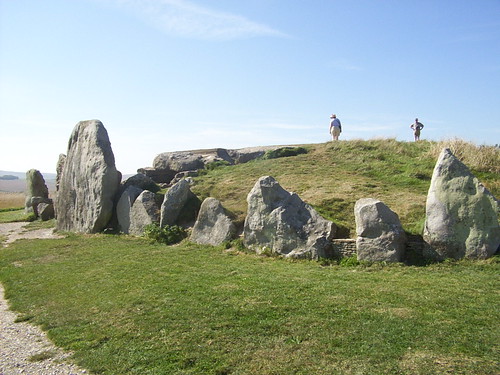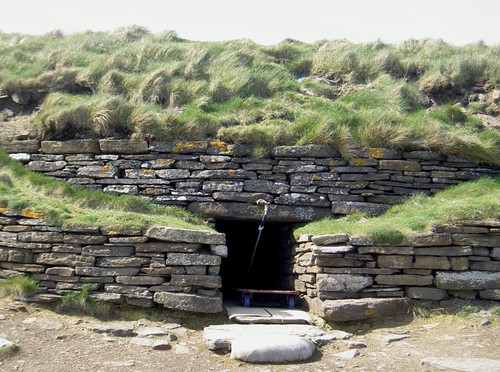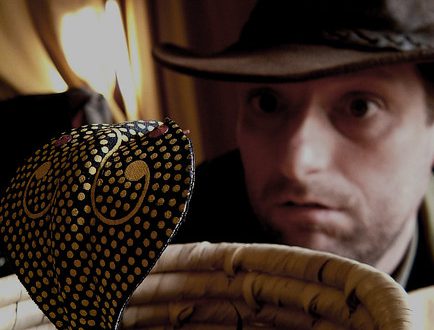For the archaeologist and anthropologist, excarnation refers to a specific burial practice. It is the removal of the flesh off the skeleton, leaving only the bones to be buried, which could be allowed to occur naturally (by leaving the body out in the open, for example) or the process could be done physically, which can leave signs of scraping on the bones.
So why is there the need to de-flesh bones and then dislocate them from the body in many prehistoric cultures? And which cultures in particular does this occur in?
Mind the Fingers and Toes!
Let’s pull up a few sites and investigate some of the theories. Excarnation is common practice in the late British neolithic. Sites such as West Kennet Long Barrow in Wiltshire has had in total 46 individuals excavated from its chambers. In West Kennet many bones seem to be missing from bodies and the rest are totally jumbled up.
This apparent disorder, the dislocation of bodies and the missing parts of skeletons found inside some of these tombs could imply one of two things. Either that the deposition of disarticulated remains had taken place following excarnation, or, alternatively, that the chambered tombs represent vaults to which successive burials have been added over time. In the latter process the bodies which have been previously laid to rest are disturbed and messed up.
That said, then why are sites such as West Kennet Long Barrow and Isbister tomb in South Ronaldsay, Orkney, found with bones and body parts missing, or indeed with animal bones added?
Archaeologists have suggested that when a person died their body would be left on a woven litter or altar. When the excarnation was complete and the flesh had rotted away, finger bones and toe bones (which are very small) could fall through gaps in the woven structure or roll off the side. Thus, when a site with a lot of small bones only is found, it is highly likely to be a site for excarnation. Furthermore when a tomb with no smaller bones is found it is because they have been lost along the way.
Tomb of the Eagles
Isbister Tomb in South Ronaldsay in Orkney, Scotland, contains human bones representing 340 people. The skeletons were disarticulated and incomplete, the bones bleached and weathered, making it very probable that the bodies had been laid out once on mortuary platforms, exposed to the elements and birds of prey, before ultimate interment. Isbister is also known as the ‘Tomb of the Eagles’, as they found the talons and bones of sea eagles in with the human bones.
It is possible that the sea eagle would have been a totem for these people, it represents flight and travel, symbols which are boldly associated with journey and travel to an afterlife. However, again we are assuming and cruedly transplanting 21st century assumptions onto a prehistoric island society.
But hey, a sea eagle has always lived by the sea, and flown, right? and Orkney has always been an island so how far from the truth can we be?
Zoroaster and Excarnation
Another example of excarnation where it is recorded that birds and elements had parts to play is in the Zoroastrian tradition, a tradition based on the teachings of prophet Zoroaster (aka Zarathustra, in Avestan) and probably founded some time before the 6th century BC in Iran.
They considered a dead body with all the nails and hair to be unclean. Therefore the bodies of the dead are placed on top of a tower, exposed to the natural elements and the birds of prey. The roof was divided into three concentric rings: The bodies of men are arranged around the outer ring, women in the second circle, and children in the innermost ring. Once the bones have been bleached by the sun and wind, which can take as long as a year, they are collected in an ossuary pit at the center of the tower, where, assisted by lime, they gradually disintegrate. The remaining material with run-off rainwater runs through multiple coal and sand filters before being eventually washed out to sea.
The Vultures at atalhyk
 Lastly and more recently pictures of vultures hovering above headless corpses and piles of human skulls and bones under what appears to be structures of reed and matting have been found at atalhyk. This evidence for the archaeologist is a bright red flashing light connected to death and ritual, and gives direct connotation and evidence to the dead being excarnated here.
Lastly and more recently pictures of vultures hovering above headless corpses and piles of human skulls and bones under what appears to be structures of reed and matting have been found at atalhyk. This evidence for the archaeologist is a bright red flashing light connected to death and ritual, and gives direct connotation and evidence to the dead being excarnated here.
The bodies of the dead were buried about two feet under the floors of houses and shrines. Scientific evidence suggests the bodies were never buried immediately after death but were placed in the graves only after their flesh had been removed. Archaeological evidence also proves that the skull must have been of considerable importance, because firstly the paintings denote headless corpses, but secondly during the excavation of corpses the only part left undisturbed were the brains.
This method of funerary disposal seems to be echoed in many parts of the world and over many ages. It also reiterates that death is most definitely not an isolated event, confined to that second that one passes over. Rather, death has an omnipresent power over the living, it is the unknown which is feared and then this fear which dictates how we live.






